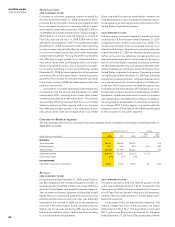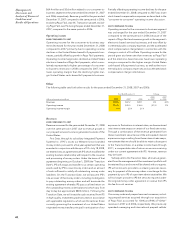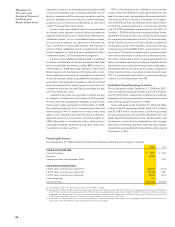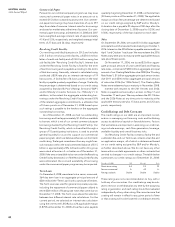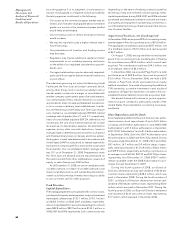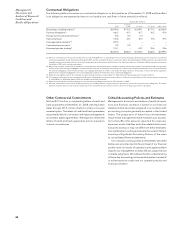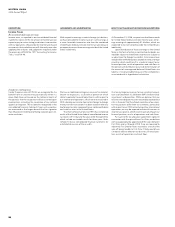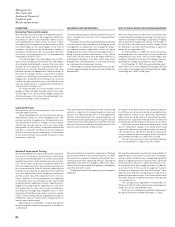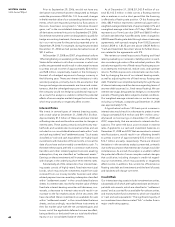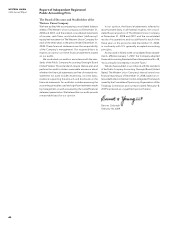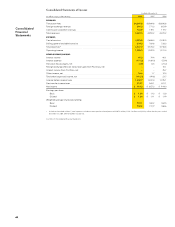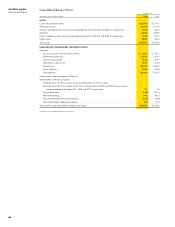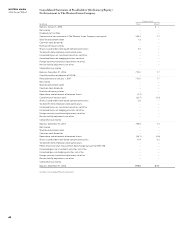Western Union 2008 Annual Report Download - page 40
Download and view the complete annual report
Please find page 40 of the 2008 Western Union annual report below. You can navigate through the pages in the report by either clicking on the pages listed below, or by using the keyword search tool below to find specific information within the annual report.
WESTERN UNION
2008 Annual Report
3838
DESCRIPTION
Stock-Based Compensation
We have stock-based compensation plans, which include
stock options, restricted stock awards and units, unre-
stricted stock awards, and other equity-based awards
granted to employees and other key individuals who
perform services for the Company. See Note 2, Summary
of Significant Accounting Policies, and Note 16, Stock
Compensation Plans, in the notes to the consolidated
financial statements for a complete discussion of our
stock-based compensation programs.
We currently utilize the Black-Scholes option pricing
model to measure the fair value of stock options granted
to employees and directors.
JUDGEMENTS AND UNCERTAINTIES
Option-pricing models require us to estimate a number
of key valuation inputs including expected volatility,
expected dividend yield, expected term and risk-free
interest rate. The most subjective estimates are the
expected volatility of the underlying stock and the
expected term when determining the fair market value
of an option granted.
Beginning in 2008, we used a blend of implied vola-
tility and peer group historical volatility. Our peer group
historical volatility was determined using companies
in similar industries and/or market capitalization. Our
implied volatility was calculated using the market prices
of traded options on our common stock. Prior to 2008,
our volatility was determined based entirely on the cal-
culated peer group historical volatility since there was
not sufficient trading history for our common stock or
traded options.
In addition, our expected option terms are based in
part on stock option exercise activity when we were part
of First Data.
EFFECT IF ACTUAL RESULTS DIFFER FROM ASSUMPTIONS
Our volatility and expected option term assumptions
could be significantly different going forward than what
we have estimated for historical grants which could impact
our stock-based compensation expense in future periods.
A 10% change in our stock-based compensation
expense for the year ended December 31, 2008,
would have affected pretax income by approximately
$2.6 million.
Restructuring and Related Activities
We have engaged in restructuring actions and activities
associated with productivity improvement initiatives and
expense reduction measures, which are accounted for
under SFAS No. 112, “Employers’ Accounting for Post-
Employment Benefit” (“SFAS No. 112”), SFAS No. 146,
“Accounting for Costs Associated with Exit or Disposal
Activities” (“SFAS No. 146”) and SFAS No. 88, “Employers’
Accounting for Settlements and Curtailments of Defined
Benefit Pension Plans and for Termination Benefits.”
We also evaluate impairment issues associated with
restructuring activities under the provisions of SFAS
No. 144, “Accounting for the Impairment or Disposal of
Long-Lived Assets.”
Restructuring and related expenses consist of direct
and incremental costs associated with restructuring and
related activities, including severance, outplacement
and other employee related benefits; facility closure
and migration of our IT infrastructure; other expenses
related to relocation of various operations to existing
company facilities and third-party providers, includ-
ing hiring, training, relocation, travel, and professional
fees. Also included in the facility closure expenses are
non-cash expenses related to fixed asset and leasehold
improvement write-offs and acceleration of depreciation
and amortization.
These costs represent management’s best estimate, until
all such amounts are paid and settled. As such, these
costs require assumptions about the activities that may
change over time.
The decision to include a cost in the restructuring
disclosure requires an assessment of whether the cost is
direct and incremental to the productivity improvement
initiatives and expense reduction measures. This assess-
ment can require judgment depending on the nature of
the cost.
The timing of recording these costs was determined
by the applicable accounting guidance under SFAS
No. 112 and SFAS No. 146. This judgment significantly
impacted the restructuring and related expenses recog-
nized on a quarterly basis. However, as all of the restruc-
turing and related expenses were incurred during 2008,
the judgment required at year end in determining the
appropriate accounting estimate is significantly reduced.
The restructuring and related expenses are evaluated
periodically to determine if an adjustment is required.
Should the actual amounts differ from our estimates, the
amount of the restructuring and related expenses could
be materially impacted.
For the year ended December 31, 2008, we incurred
$82.9 million of restructuring and related expenses. As
of December 31, 2008, $25.8 million remains unpaid
related to restructuring and related expenses.


